|
Sept. 18, 2009, at 4 p.m. Location: Peach Road south of Plymouth, Indiana. Chief Menominee and his band of Potawatomi were forcibly removed from Indiana to Kansas in 1838, and so many died it is called the Trail of Death. See www.potawatomi-tda.org for pictures, diary and route taken. The statue was erected in 1909, paid for by the State of Indiana. Supper at 6 p.m. at Menominee Elementary School, 815 Discovery Lane, Plymouth, is $6.00. This commemoration is sponsored by Wythougan Valley Preservation Council, Plymouth IN and Potawatomi Trail of Death Assn. of Fulton County Historical Society, Rochester IN. Several Potawatomi who had ancestors on the Trail of Death will attend and take part in this ceremony and also the Trail of Courage festival Sept. 19-20, at Rochester. 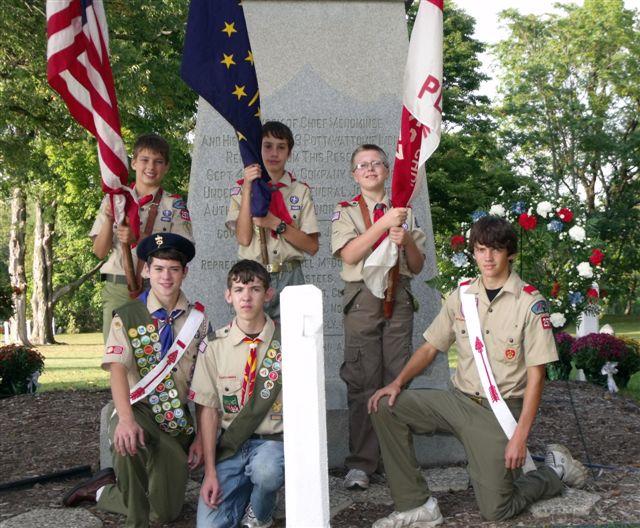 Boy Scouts hold flags in front of Chief Menominee statue. They also had flags from Potawatomi nations. (Photo by Lyn Ward.) 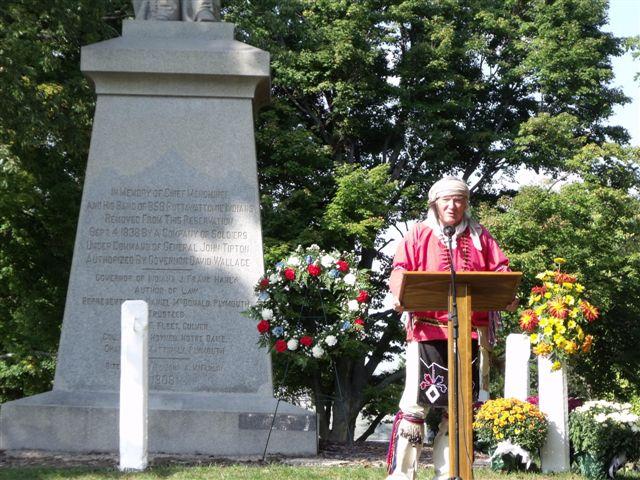 George Godfrey told about the events leading up the 1838 removal. (Photo by Lyn Ward.) 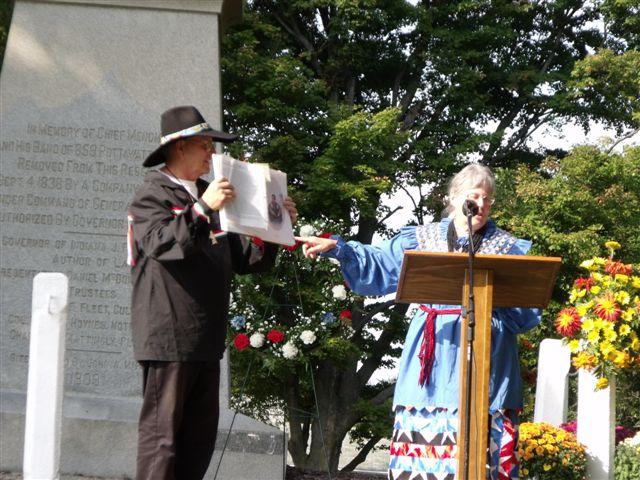 Bill Willard held the George Winter book while Shirley told about Mas-saw, a Potawatomi woman pictured in the book and who went west on the Trail of Death. (Photo by Lyn Ward.)
Sept. 19-20 at Fulton County Historical Society grounds 4 miles north of Rochester, Indiana, on US 31. Admission charged. Contact FCHS at 574-223-4436, E-mail: web site: www.fultoncountyhistory.org. Trail of Courage has teepee village, wigwam village, over 200 historic camps, 1,200 participants in frontier clothes, foods cooked over wood fires, Chippeway Village of 1832, two stages with frontier music and dance 10 am to 5 pm, Indian dances 2 pm - 3 pm. Muzzleloading shooting contests, Mountain Man tug of war, many children’s activities, canoe rides on Tippecanoe River, pioneer crafts demonstrated and sold, so much you cannot see it all in one day. Many benches to rest on, handicapped accessible. Free trams from free Fulton County Museum and round barn at north end of grounds.
The Chief Menominee monument was erected and dedicated 100 years ago September 4, 1909. A special remembrance program is being planned for Sept. 18 at 4 p.m. Supper will follow at 6 p.m. the Menominee Elementary School, 815 Discovery Lane, Plymouth, for $6.00. The public is welcome. Many Potawatomi who had ancestors or relatives on the forced Trail of Death removal from Indiana to Kansas in 1838 will attend and participate in the program. Speaking at the ceremony will be:
Boy Scouts will post the colors and flags of the Potawatomi nations. The ceremony is sponsored by the Wythougan Valley Preservation Council, Plymouth, assisted by the Potawatomi Trail of Death Assn., a branch of the Fulton County Historical Society, Rochester. Both groups will have meetings after the supper at Menominee Elementary School. In 1909 local and state dignitaries spoke, including State Representative Daniel McDonald, Plymouth, and Congressman Henry Barnhart, Rochester. John Cavanaugh, president of the University of Notre Dame, and Very Reverent Andrew Morrissey, Provincial of the Congregation of the Holy Cross, gave the invocation. The statue was unveiled by Julia Pokagon, member of the Pokagon Band of Potawatomi, Michigan. The complete program can be seen on the Potawatomi Trail of Death Assn. web site www.potawatomi-tda.org. The statue was paid for by the Indiana State Legislature, at the request of Daniel McDonald. He was editor of the Plymouth newspaper and author of two books: “History of Marshall County Indiana” in 1881, and “Removal of the Potawatomie Indians from Northern Indiana” in 1899. On Feb. 3, 1905, he gave a speech to the Indiana House of Representatives, Indianapolis, telling about the Trail of Death and introducing the Bill to Erect a Monument to the Pottawattomie (that is the way it was spelled at that time) Indians at Twin Lakes, Marshall County. The bill was passed and $2,500 was granted to erect a statue of Chief Menominee, the man who would not sign the treaty and sell his land. The sculptor was John Novelli, a graduate of Academy of Fine Arts in Rome. He was paid $1,875 to build the Menominee monument. The land was part of the Vandalia Railroad and the people rode the train to attend the ceremony. Today there is a blacktop road, South Peach Road, by the statue. On US 31 south of Plymouth there is a sign “Chief Menominee monument” pointing west. Go about six miles and turn north on Peach Road. The statue is on the east side of the road. The Trail of Courage Living History Festival will be Sept. 19-20. This is the 34th year for this amazing festival which portrays frontier Indiana and honors the Potawatomi Indians at the Fulton County Historical Society, Rochester. It is located at the FCHS grounds 4 miles north of Rochester on US 31.
By Shirley Willard, Fulton County Historian There’s history in the wind here. Red-tailed hawks circle over head, nuts fall on the tin-roofed booths and cabins, Indian flute music floats on the breeze. Take a walk through history at the 34th annual Trail of Courage Living History Festival Sept. 19-20 at Rochester. The Potawatomi Indians were marched single file down Rochester’s Main Street September 5, 1838, on the forced removal known as the Trail of Death. Since 1976 this festival has honored the American Indians and shown life before the removal when this was still Potawatomi Territory. The Trail of Courage will be held at the FCHS grounds four miles north of Rochester on US 31. Admission is $6 for adults, $2 for children (6 through 11), and free age 5 and under. Hours are Sat. 10 a.m. to 6 p.m. and Sun. 10 a.m. to 4 p.m. Frontier Indiana comes alive with foods cooked over wood fires, period music and dance, traditional crafts, historic camps and trading, canoe rides on the river, and much more. It is produced by the Fulton County Historical Society. This event combines genealogy of the Potawatomi Indians and the settlers who lived in Fulton County and northern Indiana in the early 1800s with the rendezvous events and stage programs and the historic canoe landing and fur trade skit on the Tippecanoe River. This year’s honored Potawatomi family will be descendants of We-wis-wa. Eddie Joe Mitchell, Prairie Band Potawatomi, Mayetta, Kansas, and other family members will tell their story at 10:30 a.m. on the Chippeway Village stage both days. Sherry Fulton, County Commissioner, will present a key to the County to them on Saturday during Opening Ceremonies at 10 a.m. New this year will be River Valley Colonials Fife & Drum Corp, Sun Prairie, Wisc.; McCartney Militia, Allegan, Mich. - Revolutionary War cannon; Shirley Kern Needham with wild hawks, Rochester; Joan McClellan and family, Rochester - Indian tacos and fry bread; Mike Floyd, Logansport, Eel River Tribe history; Norman Rhoads, Plymouth, Spirit of Many Waters - long house; and several new crafts such as Tim Guy, Huntington - Forks of the Wabash bowlwright, and Dave Short, South Bend, flintknapping and traditional tool working. Over 40 craftsmen will demonstrate and sell their wares. Dr. John Haste, Argos, will bring horses this year. The public is invited to join in the Indian dances from 2:00 to 3:00 p.m., which are held in an arena semi-circled by teepees. The drum will be Massassagan Drum led by Mike Floyd, Chief of the Eel River Tribe. Head dancers will be Bonita Bent-Nelson and Doyle Blooding, South Bend; both are members of the National Center for Great Lakes Native American Culture. George Godfrey, Athens, Illinois, member of the Citizen Potawatomi Nation, will act as emcee. He is president of the Potawatomi Trail of Death Association, and has been dancing at the Trail of Courage since 1988. Godfrey had an ancestor on the 1838 Trail of Death. The Trail of Courage includes historic encampments representing the French & Indian War, Voyageurs, Revolutionary War, War of 1812, Western Fur Trade, Plains Indians teepees, and Woodland Indian wigwam village. A special re-creation of a Miami Village includes wigwams and lifeways demonstrations, such as making cattail mats. Another re-creation is of Chippeway, the first trading post, post office and village in Fulton County in 1832. Food purveyors and traditional craftsmen set up in wooden booths. Craftsmen also sell pre-1840 trade goods from blankets and in historic merchant tents, offering a variety of items from clothing and jewelry to knives and candles, everything needed to live in frontier days. Canoe rides, muzzle loading shooting and tomahawk throwing contests, and a frontier blab school add to the frontier activities. Two stages with frontier music and dance present programs from 10 a.m. to 5 p.m. Saturday and 10 a.m. to 4 p.m. Sunday. Since the early 1980s FCHS has received grants from the Indiana Arts Commission and the National Endowment for the Arts to help pay for musicians and dancers: 42nd Royal Highlanders, River Valley Colonials Fife & Drum Corp, Aztec dancers, Shakin’ Hammers String Band, Mark and Liza Woolever, Steve McPhail - Johnny Appleseed, Chuck Molenda - Ben Franklin, Chief White Eagle - Indian lore, Indian dancers and drum. Many volunteers provide programs such as Frontier Frolic dance called by Shirley Willard, Nan Edwards and Margo Moore’s dogs pulling travois, Marsha Glassburn - Indian storytelling, and Riddle School 4th grade dancers, Shirley Kern Needham - red-tailed and red shoulder hawks; Mark Gropp - bagpipes. Both Catholic and Protestant worship services are held at 9:00 a.m. on Sunday. Pioneer foods are cooked over wood fires. Visitors can feast on buffalo burgers, chicken and noodles, barbecue, ham and beans, fish and chips cooked in big iron kettles, potato brats, apple dumplings, corn on the cob, apple sausage, and more, including ice cream, one of George Washington’s favorite treats. Local clubs cook and serve these historic foods to fund their projects: Rotary, Kappa Delta Phi, Swingin’ Dudes Square Dancers, Grass Creek Lions Club, and Fulton County Historical Society. Beverly Jackson and family, Rochester, do the barbecue and sweet potato pie, and also exhibit a frontier African-American house. Many people come to the festival just for the delicious food! The grounds are handicapped accessible. Free tram rides are available to bring people from the museum, round barn and Living History Village, which will be open, at the north end of the grounds. Volunteers can earn free admission to the Trail of Courage by working half a day. To volunteer or for more information, call the museum at 574-223-4436. Free parking is provided on FCHS grounds. Plenty of free benches are available to sit and rest. Visit our websites www.fultoncountyhistory.org and www.potawatomi-tda.org.
By Shirley Willard, Fulton County Historian Edward Joseph Mitchell was born in 1952 to Potawatomi parents at Pawnee, Oklahoma, the government hospital where expectant mother were sent that year because the Prairie Band reservation had no money. He wrote: “I grew up on the Prairie Band Potawatomi reservation at Mayetta, Kansas, before casinos. We were poor. We didn’t have electricity, running water, telephones or computers. Not many had cars. The roads were dirt roads, no gravel. Many still spoke the Potawatomi language. There were hardly any employment opportunities. Many people left the reservation because of this. “I see that the casino has brought much change, that is, if you measure things in material ways. People that didn’t want to be Indian before have moved back because of the money. We still have social problems we don’t want to speak of. The government system we have today is like the old fort system. The ones closest to the fort benefit the most. Many of the people that work in the system use the system for themselves. Sounds like the rest of U.S. according to the headlines. “Seven out of eight of my great grandparents were enrolled Potawatomi so I am 7/8ths Potawatomi. They were either Prairie Band or Citizen Band allottees. I can’t pick one branch of my family over the rest. I haven’t been able to document our Citizen Band side other than they were on the allotment rolls so I don’t know if they came from Indiana. Nor can I say that Chief We-wis-sa or We-wah-seh was related to me. My great grandfather’s name was We-wah-seh and is on the 1849 Citizen Band allotment roll under number 1211. He is not the one that was on the march from Indiana. I feel there was a connection to the Chief We-wis-sa because of the practice of naming after ancestors. There must be a connection for my great grandfather to have used that name. “My father’s name is Andrew Mitchell. He father was Joe Mitchell (or Ash-puk-kee) Prairie Band allottee. Joe’s father was James Mitchell or We-wah-seh, Citizen Band allottee. Joe’s mother was Wamtogoshekwe, Prairie Band allottee. Andy’s mother was Angeline Battese, Citizen Band. Angeline’s parents were Mitchell Battese, and Mary Manekukjish, Citizen Band allottee. “My mother was Alberta Nagmo. Her dad was John Nagmo (or Tekahko), Prairie Band allottee. John’s parents were Shough-nosh and Sha-no-kwe, Prairie Band allottees. Alberta’s mother was Hattie Lasley, Citizen Band. Hattie’s parents were James Knoxsah Lasley and Sara Ann Blandin, Citizen Band allottees. “My mother was fluent in English and Potawatomi. I learned my language from her. Her dad refused to speak English but taught her the Potawatomi language. Both my parents became involved in our ceremonial traditions. I am a speaker in many Prairie Band ceremonies because of my knowledge of the language. “I have a Potawatomi wife, Mary. We have a daughter Hattie and three sons: Eddie Joe Jr., William and John. I have six brothers and five sisters. Gary and Larry are twins who are a year older than me. My younger siblings are sister Jackie, brothers Andy and Leo, sisters Shirlene and Sandy, brother Randy, sister Lisa, brother Mike, sister Edie. They were born in that order. Three of my brothers are gone: Larry, Andy and Mike. My brother Gary has written several books about Potawatomi history. “I am currently a self-employed artist. I make roach head dresses, drums and many other native crafts. I make breastplates, pipe bowls and stems, Indian lacrosse sticks, wood spoons, miniature drums and breastplates, fans, gourds. The list goes on. I was in the building trades for years. I ruined my back so now I have to use my hands and speaking abilities to make a living. “For elementary school I went to an all- Indian parochial boarding school 1959- 65. Abuse was still an acceptable tool for saving the souls of Indians in those days. I wrote a chapter about it for my book (unpublished so far). I don’t know how devout Catholics will receive that part of my book. That took me a lifetime to realize that not all Catholics were like the ones I was exposed to. I still don’t go into Christian churches because of that experience. “I graduated from Mayetta High School in 1970 - it is located just off the Prairie Band reservation. I was in the Air Force from late 1970 to mid 1973. I was a computer operator. I was given a general discharge. Long story. Part of that story is I went through years of alcoholism and drug abuse and violence. It took me a long time to walk away from that. I can’t remember the last time I was involved in any of that, but I can never forget it. It is also a part of my life story. It is the chapter that is hard to write. The fact that I survived all that is part of the reason I try to give back as much as I can. “I went to Haskell Indian Junior College and graduated with an A. A. in liberal arts in 1981. My major was journalism. I attended Washburn University 1984-86, majoring in journalism. I missed my B. A. by three credit hours. I got an incomplete in an internship. I never went back to finish. “My daughter took a class in Cambridge, England. It had been a dream of mine to see other parts of the world so my wife and I went to see her and planned a trip around it. We met her in London and toured the city. Then we took a train to Paris, seeing all the famous landmarks and spent a day at the Louvre. I wanted to see the world’s great art. It can’t be seen in one day but I was able to experience it. We took a train to Rome. I wanted to see the Sistine Chapel because I read that Michelangelo was inspired by God to do it. So I had to see that work with my own eyes. It was inspiring. We flew back to London and went to Stonehenge. We saw as much as we could. “I have held numerous jobs. I worked for the Prairie Band Potawatomi in the enrollment department. I completed over 4,000 family trees for them. I am well versed in Prairie Band genealogy and their history. “The Wamegos on Prairie Band roll are different families than the ones on Citizen Band roll. Some names are like Jones and Smith, quite common. Another point: Citizen Band history didn’t just didn’t move to Oklahoma in the 1860s. Many, like my ancestors, were absorbed into the Prairie Band. I would say at least one third of the roll has Citizen Band blood in them. “One job I enjoyed was working with Native American Indian prisoners. I was listed as a spiritual advisor. I met hundreds of Indians that were locked up. I conducted traditional ceremonies with many of them. “Currently I am writing an autobiography. It is my story. It has taken years to live, so it is taking me time to write it. I hope to leave that for my unborn grandchildren. I want them to know of the life I have seen. “I am active in keeping our traditional ways alive. I have devoted my life to learning our ways and carrying them on.” Eddie Joe and his wife’s brother, Thomas Wabnum and son Marshall, traveled with the 2008 Trail of Death Commemorative Caravan from Indiana to Kansas. He wrote about this in his Blog on his website www.reznjun.com. Eddie Joe will take part in the Chief Menominee statue 100th anniversary ceremony Sept. 18 at 4 p.m. He will also attend the Trail of Courage Living History Festival Sept. 19-20, selling and demonstrating his crafts. He will be the honored Potawatomi family at the Opening Ceremony and be presented a Key to the County by Fulton County Commissioner, Sherry Fulton. He will tell his family and tribal history 10:30-11 both days. 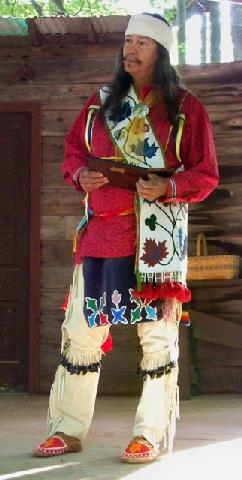 Eddie Joe Mitchell with key to Fulton County, presented at Trail of Courage.
Chief We-wis-sa (also spelled We-we-say) was one of the Potawatomi chiefs sketched by George Winter, the frontier artist, in July 1837 at the treaty council at Lake Kee-nau-nay (now Lake Bruce). Winter wrote that We-wis-sa and M’-jo-quis danced side by side with admirable grace. Winter later made an oil painting of We-wis-wa, which is now in the Tippecanoe County Museum, Lafayette, Indiana. Col. Abel C. Pepper, Indian agent, designated several younger men as chiefs because he could not get the old village chiefs to sign the treaty and sell their land. These chiefs included Iowa, Pashpoho, and We-wis-sa. After they signed the treaties, Ashkum and Checawkose threatened to kill them for selling the land. The government assigned Judge John W. Edmunds to hold a trial at Logansport to determine who the rightful owners were and if they owed the traders. Ewing and Walker trading firms had huge bills that the Potawatomi had signed when purchasing items on credit. The bills were so big, there was very little left for the Indians. Goods were sold to Indians at prices 10 times higher than the price to white people. We-wis-sa was one of the Potawatomi who testified at the trial. We-wis-wa at first was in favor of going west but he later withdrew from the Removal Camp at Crooked Creek. Then he changed his mind again and went west in 1837 with a group led by George Profitt. However, he came back to Indiana, apparently not liking the flat tree-less Kansas. When General John Tipton brought militia (volunteer soldiers) to round up the Potawatomi at Chief Menominee’s village at Twin Lakes, We-wis-sa and his family were among them. The men were held captive in the chapel for 3 days while squads of soldiers searched a 30 mile radius to round up all the Potawatomi they could find. On Sept. 4 they began the march to Kansas, heading not west but east to the Michigan Road (now Old 31) and then south. They camped the first night at the Tippecanoe River north of Rochester. They were marched at gunpoint single-file down Rochester’s Main Street on Sept. 5, 1838. Eyewitnesses lined the streets. Some housewives gave them hoecakes to take on their journey. They camped the second night at Mud Creek on Indiana 25, where a baby died, the first of 42 deaths, hence the name Trail of Death. They went on to Logansport and so many were sick, they set up a hospital where the present hospital is. Father Benjamin Petit and Bishop Brute conducted mass on Sunday, and Winter sketched that scene. On Sept. 10 they left Logansport. We-wis-sa’s mother was about 100 years old and too infirm to make the 660 mile trek from north central Indiana to eastern Kansas. She became ill and could not keep up with the marchers. It was reported that her family debated whether to dispose of her with a tomahawk to end her suffering. But she died a natural death Sept. 12, 1838, at the camp near Battle Ground, Indiana, and was buried there in an unmarked grave, which is probably in the outskirts of Lafayette. We-wis-sa’s name is found on four treaties signed on the Tippecanoe River in Fulton County: 1832, and three treaties in 1836 in which the Potawatomi agreed to sell their land for $1.25 an acre and move west of the Mississippi River within two years. He also signed two treaties in Kansas: 1846 moving them further west in Kansas, and 1861 which created the Citizen Band by offering them land in Oklahoma. It is not known where or when We-wis-sa died. 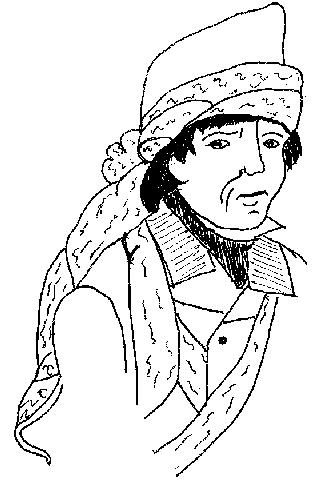 We-wis-sa as he appeared on the 2009 Trail of Courage participant badge, sketched by Annette Wise. |
| < Previous | Home | Next > |